Category Archives: Uncategorized
Quinoa, a Great Source of Protein
By: Gil Hurtado
Cookbook Entry: Quinoa, A Great Source of Protein

Protein is one of the most important nutrients our body needs in order to function properly. It is essential in repairing and creating cells. Some people erroneously believe that the only way to get protein is by eating meat. Although it’s true that it is high in protein, it’s not the only source. Protein can be found in many other food items. Beans, nuts, and avocado are a few examples. But for now, I will explain why I gave up eating meat as well as discuss quinoa, which is one of my favorite foods with a very high amount of protein. It is sometimes mistaken for a whole grain. However, it is actually a seed which is found in many areas in South America (UWIRE, 2012).
Most people are brought up in households that include meat in their diet. If you’re like me, the concept of protein wasn’t even discussed. In reality, what people eat is due to a traditional or cultural beginning. What we eat depends on where we are from. If it was placed in front of us, we ate it without thinking about it or questioning it. This tradition includes meat. In time, some people make the decision to move away from this tradition. The degree of the change will vary from individual to individual. Some make a choice of eating only fish while others avoid eating any animal product whatsoever. The reason for this change will also vary. Some change for ethical, moral, personal health, spiritual, or religious reasons. Some give it up because of the thought of eating the flesh of a living creature doesn’t appeal to them anymore (Hirscher, 2011).
For me, it was a combination of things. In 1979, I was visiting relatives in Guadalajara Mexico. They thought it would be exciting for me to see a bullfight. It was one of the most horrific exhibitions I had ever seen. The poor bull was tortured and stabbed numerous times before the matador finally took it out of its misery. I was appalled by the reaction of the people attending this assault on this beautiful creature. I felt that the real beast was us. From this point on, the thought of eating meat bothered me. Although, it still seemed very normal to consume it. About twenty years later, I made the decision that I could no longer be part of sacrificing a living creature for my consumption. With the help of my wife, I found an assortment of meat-free options. My doctor insists that I continue to eat fish in order to get certain nutrients that are good for my heart. That is when I became a pescatarian. Many people don’t know what a pescatarian is. Some people tell me that it sounds like some sort of religion. It’s much easier to refer to myself as a vegetarian.
For some people who eat meat, the fact that they do not kill the animal prevents them from making the connection of guilt. Of course, unless that person is a hunter. Vegans and vegetarians do make this connection (Hirscher, 2011).
Maintaining proper health requires both exercise and nutrition. Exercise alone is not enough. A recent survey of nearly 1,500 participants found that the best diet quality scores, belonged to vegans. Also, a recent study was conducted that compared people that consume meat versus those that don’t. The results indicated that those that don’t consume meat have better results in lower body fat, blood pressure, and cholesterol. This translates to a lower risk of heart disease (Glick-Bauer, Yeh, 2014).
Prior to making my transition to a pescatarian diet, I was feeling healthy. I have always been extremely active. I had an exercise routine that included running 3-5 miles per day, five days a week. Weight lifting 3-4 times a week. Although I felt great, I was weighing slightly under 300 pounds. As I changed my diet, my weight began to drop rather easily. Over time, I dropped over 90 pounds and have maintained this weight since.
Being a vegan, vegetarian, or pescatarian is becoming more common. It is difficult to know the real number of those that don’t consume meat. This is due to the fact that there are many people that claim to be vegetarian yet, they tend to consume some level of food products that contain meat in them (Juan, Yamini, Britten, 2015).
When I first made the transition to my new diet, friends and relatives thought that I was kind of weird. As time passed and weight loss became obvious, my diet became more acceptable. Congratulatory words started to come my way. Questioning me as to how I can discipline myself from eating meat became common. Some of my original critics changed their eating habits to some degree. Some became pescatarian while others just gave up eating red meat.
One of the hardest things for those wanting to be a vegetarian has to do with eating out. Whether it’s eating at a restaurant or at gatherings with friends. For me, this was not a problem. I was determined to respect life that finding something on a menu, although limited, was never a problem. It’s no different when going to family gatherings. There is always something to eat.
Over the last three decades, the number of vegan or vegetarian restaurants has grown. Since more and more people are realizing that eating healthier options include staying away from meat, more restaurants are catering to this growing population. Across the country, there are even restaurants that are strictly vegan, such as Native Foods (Wasserman, 2012). Vegetarian options are becoming easier to find. Some restaurants offer options that cater to both omnivores and vegetarians. One example of this is the Yard House. They offer a Gardein Menu. These are menus that duplicate the regular menu except they use substitute vegan products made from soy or tofu. To me, the taste and texture are the same. The difference is in the guilt. Even fast food restaurants are moving in this direction. For example, Burger King does offer a vegetarian patty in one of its burgers.
So, what will people eat if not meat? There are many options available. The change will depend on your motive for change. Is it for a health, ethical, or religious reason? This should be your guide. As I stated earlier, for me it was a combination of things. I wanted to feel healthy as well as wanting to free myself from the guilt of being responsible for the death of an animal. I have accomplished part of this in that I feel healthier than before. I am no different than most people. I still want to cherish the taste of my meal. Quinoa meets that criteria.
I grew up in a household where meat was always available. We typically had rice and beans that accompanied our meal. Beans do provide protein. But they lack other important nutrients. Meanwhile, rice does have protein but in small quantities. The amount of rice that a person would need to consume in order to get the necessary protein is a bit too much. This is where quinoa comes in. Quinoa provides one of the highest amounts of protein. Personally, I find it to be on the insipid side. My wife, prepares it in the same way as it was rice. She adds the right amount of spices that give it the desired flavor. She will add other items such as corn, peas, or whatever we happen to be in the mood for.
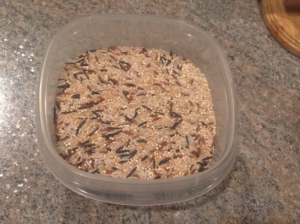

I added two photos of the types of quinoa that we prefer. One is a mixture of quinoa with brown rice. The other is plain quinoa.
Quinoa can be found in supermarkets. It comes in a variety of ways. I have bought different types, if only to mix it up a little. The two that I typically get are plain as well as quinoa mixed with brown rice and other grains. Other available options include quinoa with certain blends such as teriyaki. The point here is that you can have quinoa frequently without getting tired of the same thing over and over again. Other benefits of quinoa include that it is high in fiber and that it is gluten-free. My wife likes the fact that it actually cooks rather easily. It is usually ready in about ten to fifteen minutes.
Here is a recipe that my wife uses: (Serves five to six)
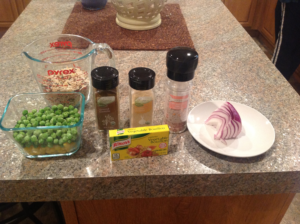
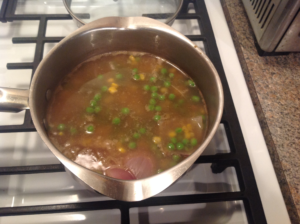
• One cup of quinoa.
• Two and a quarter cups of water.
• One fourth of an onion. (your choice of onion).
• A pinch of garlic powder.
• A pinch of ground cumin.
• One cube of vegetable bullion. (Some folks prefer chicken or beef bullion but for a vegetarian, this defeats the purpose).
• Salt (Himalayan salt) and pepper is added but, how much is up to your liking.
• One third cup of peas.
• One third cup of whole kernel sweet corn.
Cooking instructions: In a pot, place the water to heat at medium. Add the quinoa and other ingredients except for the peas and corn. The peas and the corn are added sometime around six or seven minutes later. Once the water is gone, it is ready to serve. As you can see, the measurements are not really given in a precise manner. That is because my wife does not cook like this. She has a basic idea of what the measurements are. She likes to taste the food as she is preparing it and will make slight modifications to it as she goes along. This is just one way that she prepares quinoa. She adds other vegetables that will compliment whatever the main course will be on a given day. What makes her cooking so delicious are the ingredients not listed in the recipe above. Those ingredients are very unique to her recipes. They are love and patience.
I was raised Catholic and will always say that I am Catholic. Although, I have a respect for all religions. I don’t practice any religion. Rather, I live by a philosophy. It leans towards Buddhism. I respect what yesterday was in order to learn from it. But I don’t dwell on the past nor do I have any regrets. In terms of the future, I believe in preparing for it. But I don’t dwell on it as far as setting expectations that must be met. Because life is unpredictable, I know what I should do but will make adjustments along the way, just like my wife does with her recipes. And yes, I display some modicum of patience and love. I enjoy helping others. Whether I get something in return or not is not important to me. Just knowing that I helped someone is enough. What I do today is more important than what I did yesterday or what I do tomorrow.
I love all life. I did not bring animals into the world. Therefore, I feel that I don’t have the right to take it away. I hope that one day I find a way to get the nutrients that my body needs in order for me to go vegan. Each body is different. How our bodies react to food is very unique to each of us. For now, I will follow the advice of my doctor in regards to eating fish. Mainly for the Omega
Being pescatarian is a lifestyle I have chosen for very personal reasons. My respect for all of life as well as wanting to have better health inspired my choice, I want to be clear, I respect everyone’s choice. My views are a conscious personal choice that I made and I do not push these on anyone. I don’t judge those that do eat meat rather, I only expose them to delicious and nutritious options that don’t include any animal in them. Quinoa is one of these options. It is high in protein, fiber, and other nutrients. Although it is too insipid for my taste, it can be prepared just like you would prepare rice. Quinoa can give you the delicious and healthy option without the guilt. Enjoy!
potato salads
History: The potatoes we have grown to know and love today evolved from its poisonous ancestor of the plant nightshade between Peru and Bolivia. The potato has an extensive amount of years being around; however, it wasn’t until the 8 millennia that the wild potato would be domesticated. In the 1500s Spanish conquistadores started exploring and when they came across the potato it definitely peaked their interest. They ended up taking the potato back to Europe in between the years of 1571-1593. It is funny reading on the history of a potato because I feel like it has completely made me disregard whatever knowledge I thought I had. For instance, when the potato arrived in Belgium, Germany, Austria, Ireland, and France they believed the potato was weird, unneeded, poisonous, and blamed potatoes for things like leprosy and thought to destroy the soil where it grew. Because of the warfare, people were starving and then came a botanist and chemist by the name Antoine-Augustin Parmentier, he had been studying potatoes extensively when he finally managed to persuade king Louis XVI to mass cultivation of potatoes. Once the potato was accepted it prospered. The potato flower even became a sign of nobility because of Maria Antoinette. Then came the worst, potato blight. In 1845 and 1849 potato blight ruined crops which in turn destroyed the entire potato production of Ireland. Today, this occurrence is known as the Great Famine/ Starvation because not only were potato crops being wiped out, but people that depended on potatoes as food or income began to starve, steal, and die. By the end of the great famine, it was estimated to have caused around 1 million deaths.
Nutrition: its value nutritionally is not much because it is a starch therefore it is meant you give you the sensation of being full. However, it does have vitamin C, iron, vitamin B-6, Magnesium, potassium, carbohydrates. Like I said before though, if you’re looking to get a super food then I wouldn’t really consider potatoes simply because potatoes are one of the sources of food you can get a low price and are really just meant to take up space and weight gain.
Political-Economic Analysis: Potatoes are everywhere there are so many things that can be made including potato soup, fries, alcohol, and salads. They are cheap, filling, and delicious. Potatoes are grown in farms typically these things are done by families who depend on their crop yield to survive. However, there are more than a couple who have managed to become million maybe even billionaires. I mean business will continue to boom in the potato industry so long as people keep eating fast food or buying them from the grocery store because their a cheap meal.
Symbolic Analysis: Today, I decided to bring in my boyfriends potato salad. If you know me you know I am a fairly picky eater and my dislikes include excess mayo, olives, pickles, ketchup, and mustard. However, the reason I chose this dish is because it reminded me of when I had a cooking class in high school. My teacher was the kind of lady that really wouldn’t take “but I don’t like that” as a reason to not try something and the reason she was like this was because of her grandson who she said was the pickiest eater and her daughter let it be well known before the holidays. My teacher straight up said I do not care he will eat what I make and that’s the end of that. Holidays came around and sure enough she made a dish that included almost all of the things her grandson didn’t like except she didn’t let him know. Her grandson ended up eating 3 plates of that night. The reason I bring this up is because my boyfriends potato salad includes mayo, and olives but to me it’s one of the most amazing things I’ve had and my taste buds can seriously not compute what’s going on when I eat whatever he cooks because he likes to add a lot of the things that I typically dislike.
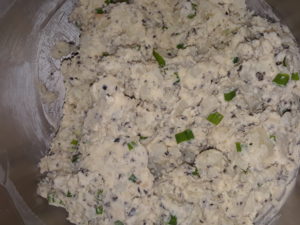
Ugent, D. (1970). The Potato. Science, 170(3963), 1161-1166.
http://www.vegetablefacts.net/vegetable-history/history-of-potatoes/
Pan Dulce
I would like to share the fond memories I have with sweet bread. Sweet bread is the comfort food that was well known in my family, which takes me down memory lane. It brings a smile to my face when thinking about it, hunger with the smell, and satisfaction once I eat it.
My parents did not have a lot money when I was growing up. My dad, may he rest in peace, used to be the sole provider for a family of nine. Money had to be stretched very thin because we were all big eaters. Therefore, one of the cheap and filling ways to go about this was feeding us hot chocolate and sweet bread, aside from rice, beans, and tortillas, in place of a meal. Because it was inexpensive, it was often served at home. My mom was hardly an affectionate person, but when she prepared this so-called meal, she was always happy and loving. One day I asked her why she was always happy when making this meal and she said it reminded her of her childhood. My grandparents were poor, and my grandma also made this meal and it was served with love. My favorite sweet breads were the conchas, mantecados, and orejitas, but the conchas were and are my ultimate favorite.
My paternal grandpa was a baker. He taught all my aunts and uncles to bake bread and hoped that at least one of them would continue the business he poured his heart and soul into, but none of them did. My dad never got into it; however, every now and then he would surprise us and make conchas. I liked sitting on the dining table and watch him mix the ingredients. The whole process caused the kitchen to become like a bakery. It is the only time I ever saw my dad wear an apron. Sometimes he would let me help him prepare the dough, place them in the oven then watch them rise into half-moons. I could never remember how he put the sugar on top of the bread, but I made sure of taking and eating one of the conchas soon after a batch would come out of the oven.
Now that I have grown up, sweet bread and hot chocolate is still a meal I have every now and then because I like it. Bread is a weakness to me and it reminds me of a childhood memory. I know that it is bad for the body; after all it is bread. I know I am taking in nothing more than calories and carbohydrates, but they are so good. I will have one here and there unless it is the holidays. I will overdo it then because the temptation is too hard to resist.
I have two kids and I have made this meal a family tradition. My kids also love eating conchas. It pleases me to see them anxiously await the sweet bread to be served with hot chocolate, like I did when I was a kid.
I imagine the way I feel when I prepare this meal is how my nom did every time she prepared it for my siblings and me. I hope that my kids will continue this tradition with their kids. Other than just a memory, it brings a sense of home, warmth and togetherness with the family.
Avocado Presentation
Toinye Williams
IDS -336 Food and Culture
Food Presentation
Spring 2018
Avocado Tree
As a child I hated avocados! Being relatively poor we didn’t eat out much and we ate leftovers and used what we had to make food last. What we did have was an avocado tree. This meant to my mother that avocado had to be put in everything! I despised the green fruit and anything associated with it well into my mid-twenties. Later a Guatemalan coworker showed me how to make delicious guacamole and I have been hooked ever since. This fruit is symbolic to me because of the history and memories I have of it but it is also influential in our economy as well.
The avocado is a fruit that is thought to have originated in parts of Mexico, Central and South America. The first avocados were planted in Florida around 1833. The production and value of the avocado in the United States is over 351 million and California production 83 percent of the volume is responsible for 328 million.
The most import thing about the avocado is the many uses for the fruit and its nutrition. As a mother of two very active boys, working full-time, a full-time student, and having a disabled husband I have gotten used to eating very unhealthy finding fast food late nights. There are several uses for the avocado and its an amazing heathy snack.
Avocados have been used in cosmetics for cleaning and moisturizing skin. Over time, the avocado will provide similar hoped for results and is much heathier for skin than chemicals found in many cosmetic products. Avocado oil is much lighter than many cooking oils, and can add flavor to many foods. The avocado for me has become a heathy food choice as it is rich in fats so prevents the need for me to overconsume but also contains antioxidants that are good for my metabolism. I have anemia and low vitamin B so while the avocado contains a low B12 it still contains B6, as well as vitamins C, E and beta-carotene. The avocado has fiber and has been studied for its contribution to prevent and treat particular illnesses.
Guacamole is one of my favorite things to make from avocados. Combined with other nutrient rich fruits guacamoles is a great snack and food topper.

Toni Guacamoni
Ingredients
4 large ripe avocados
1 finely diced roma tomato
Two table spoons of diced white onion
1/2 cup of salt
¼ cup of lemon juice (preferably from fresh lemons)
1 tea spoon paprika
Directions
Take large bowl and place pealed and pitted avocados
Smash with large spoon
Add lemon juice and mix
Add diced onion and tomato mix
Season with salt, paprika, and mix
This guacamole recipe is delicious, but there can be substations. The lemon juice can come from pre-stored or article lemon juice just does not taste quite the same in my opinion. If someone does not like onions, cilantro can be used instead. In addition, the paprika is probably never used in guacamole recipes but I think it gives it extra flavor. There almost zero cholesterol, low carbohydrates, plenty of vitamins and healthier fats. Add this to a salad or a baked chicken breast for a great tasting, good meal.
References
Boriss, Hayley, Brunke, Henrich, Kreith, Marcia Agricultural Issues Center, University of California.
Paleo, M. The most beautiful ugly fruit–the Avocado. Fight Obesity Now November 21, 2010
Over consumption

The actually looks smaller in this picture but this tray was huge! I was thinking about a talk we had in class about the large portions and it’s too true.
IHOP healthy option 😉
Here is a healthy option from the IHOP: Huevos Rancheros. My wife and I split this and substituted the buttermilk pancakes for the Harvest Grain pancakes. Restaurants will split meals and make substitutions upon request. Enjoy!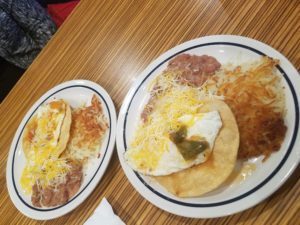
Breakfast with Gil:
 Two medium eggs, Crisp Circles, 1 Smart Dog, and 3 slices of Double French Toast Strips. Oh, and of course my first coffee of the day. 32 g. of protein with zero meat, not bad at all. I use an app called My Fitness Pal to assist my tracking of nutritional value. My goal is to maintain a nutritious menu without sacrificing taste.
Two medium eggs, Crisp Circles, 1 Smart Dog, and 3 slices of Double French Toast Strips. Oh, and of course my first coffee of the day. 32 g. of protein with zero meat, not bad at all. I use an app called My Fitness Pal to assist my tracking of nutritional value. My goal is to maintain a nutritious menu without sacrificing taste.
egg, ham, cheese, toast :)
Good morning all!
This morning I woke up early enough to make myself some food. You can’t super tell, but this is a poached egg on top of ham, string cheese, and toast. Yes it was pretty good despite appearances lol
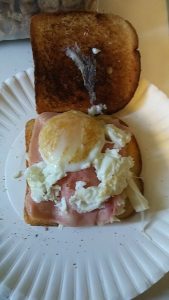
egg, ham, and cheese
More fish tacos!
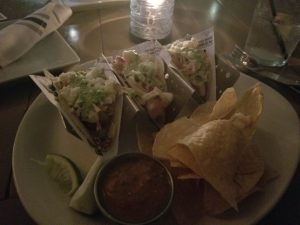
Ok, so I think it’s pretty obvious that I love fish tacos. This is a late night snack at one of my frequent stops: 21 Bar + Kitchen Torrance Marriott . These tacos are Mahi Mahi topped with chili slaw, queso fresco, and cilantro crema. The side of salsa was a bit mild in my opinion but the tacos were nonetheless, delicious.

